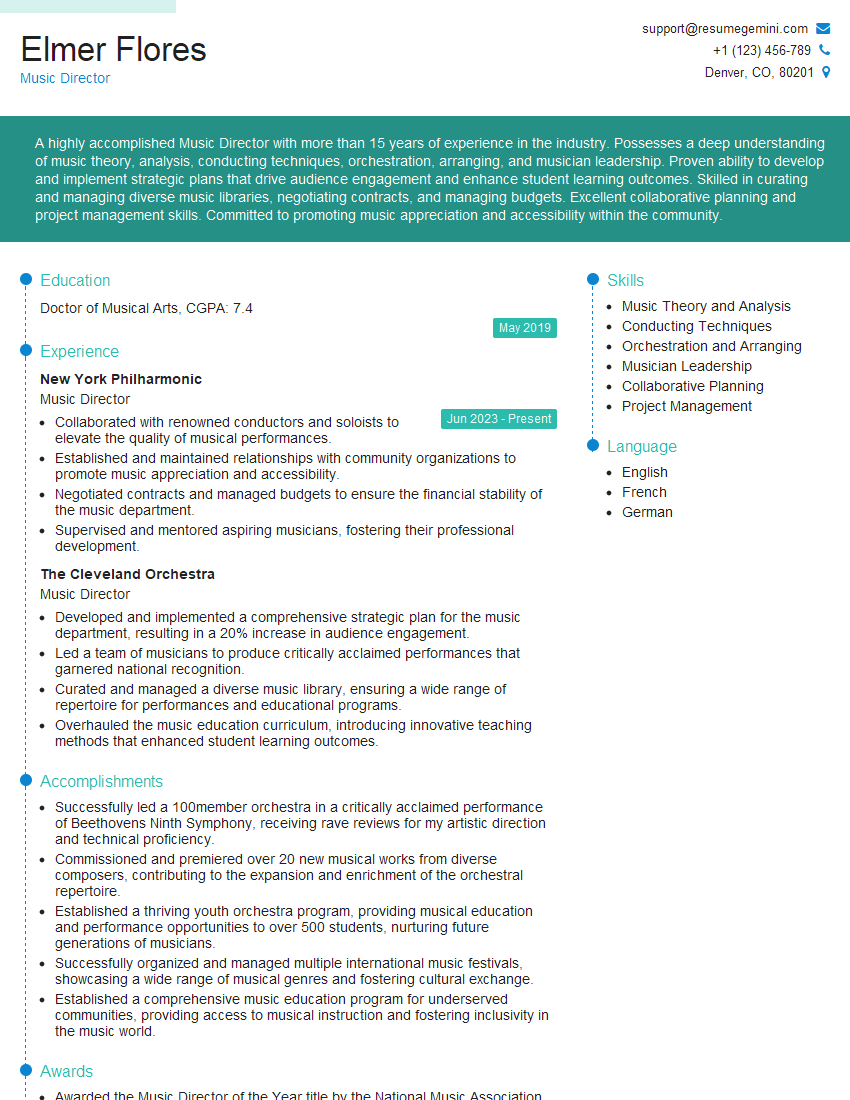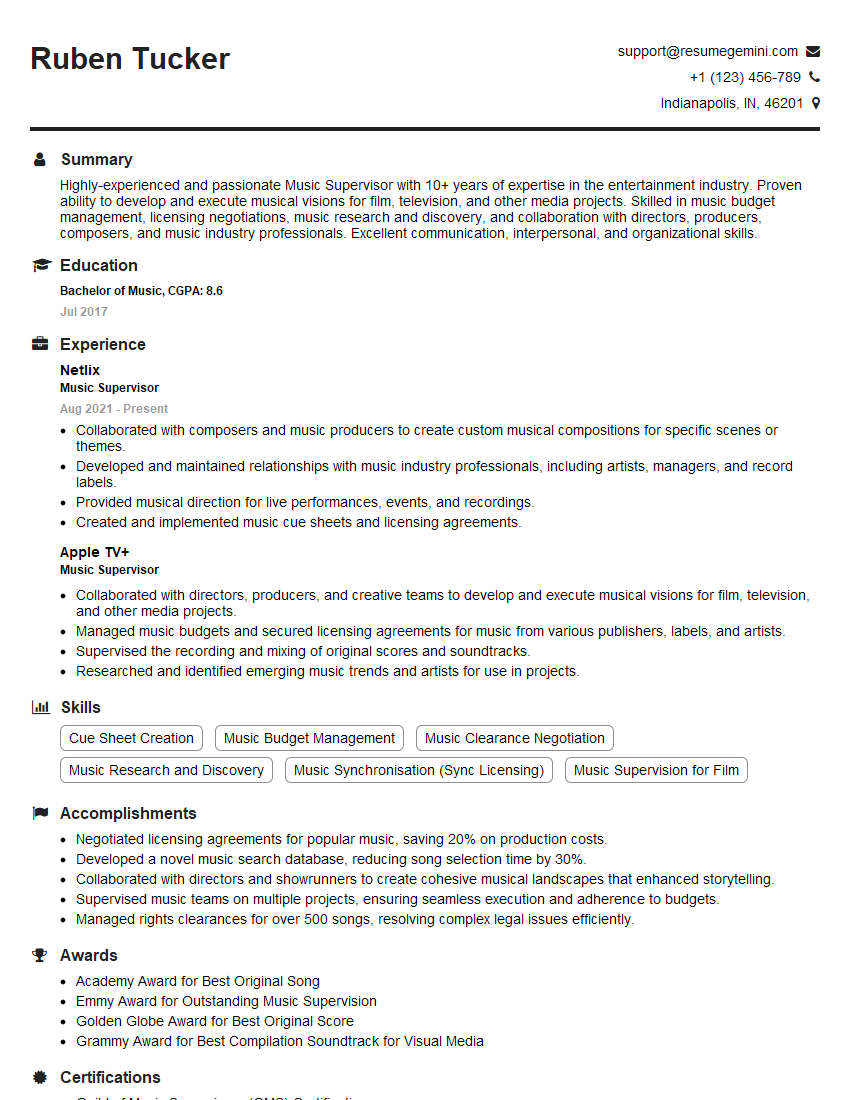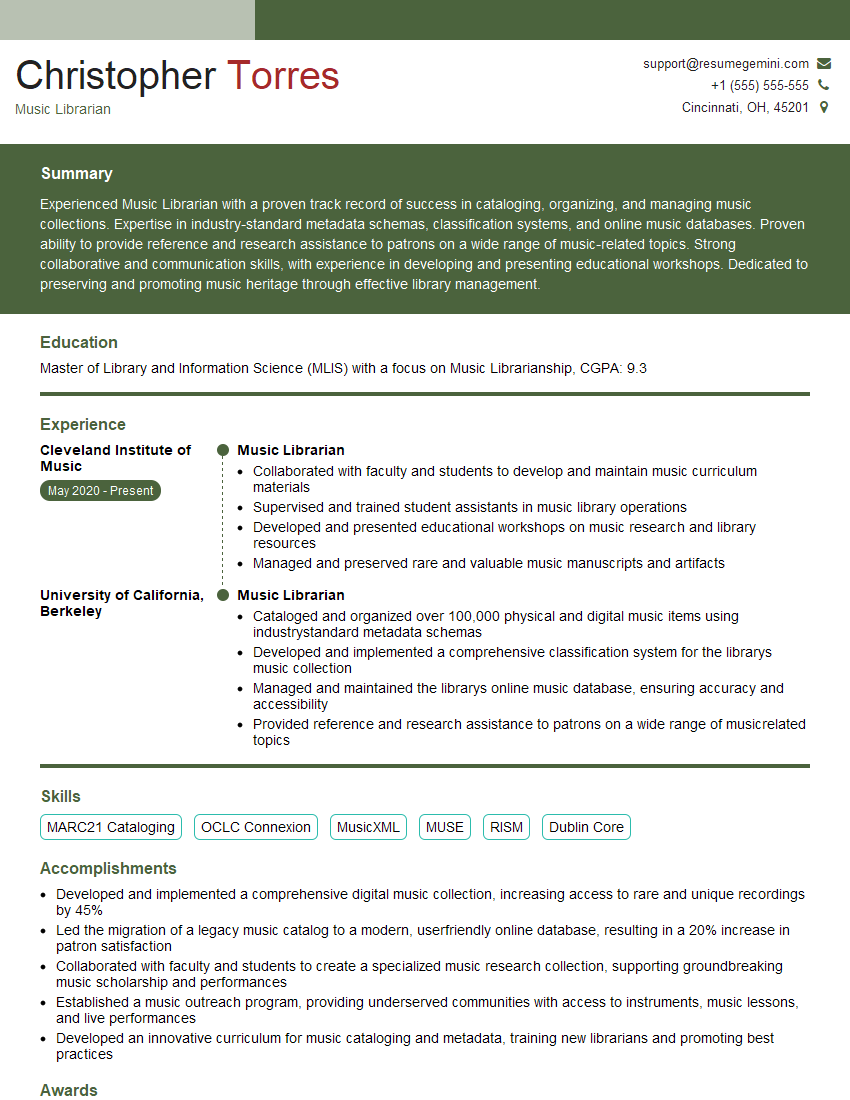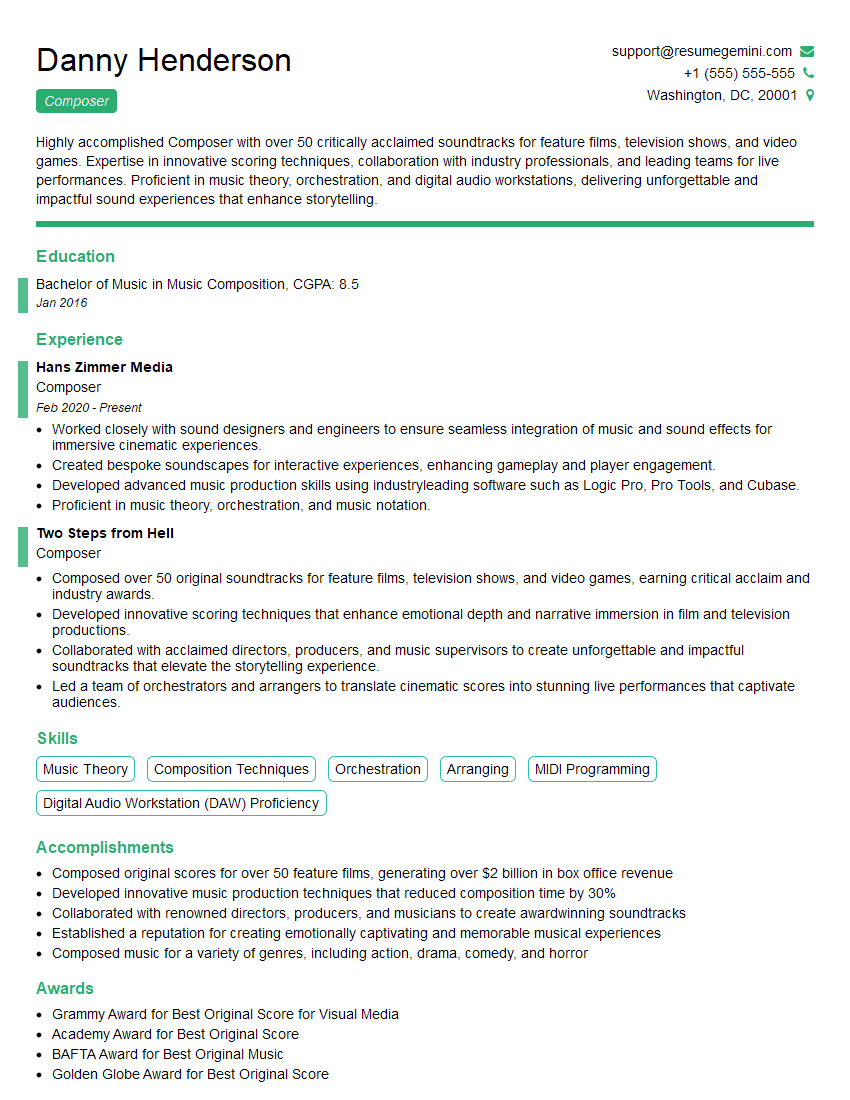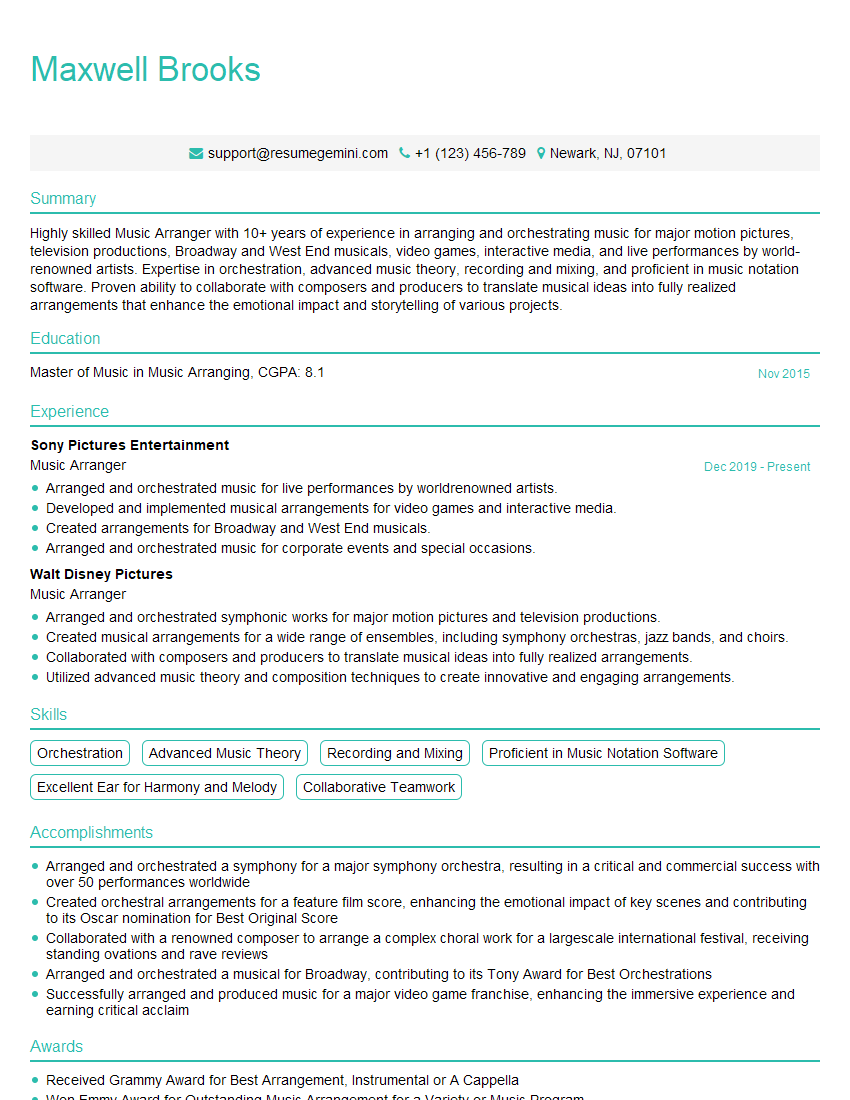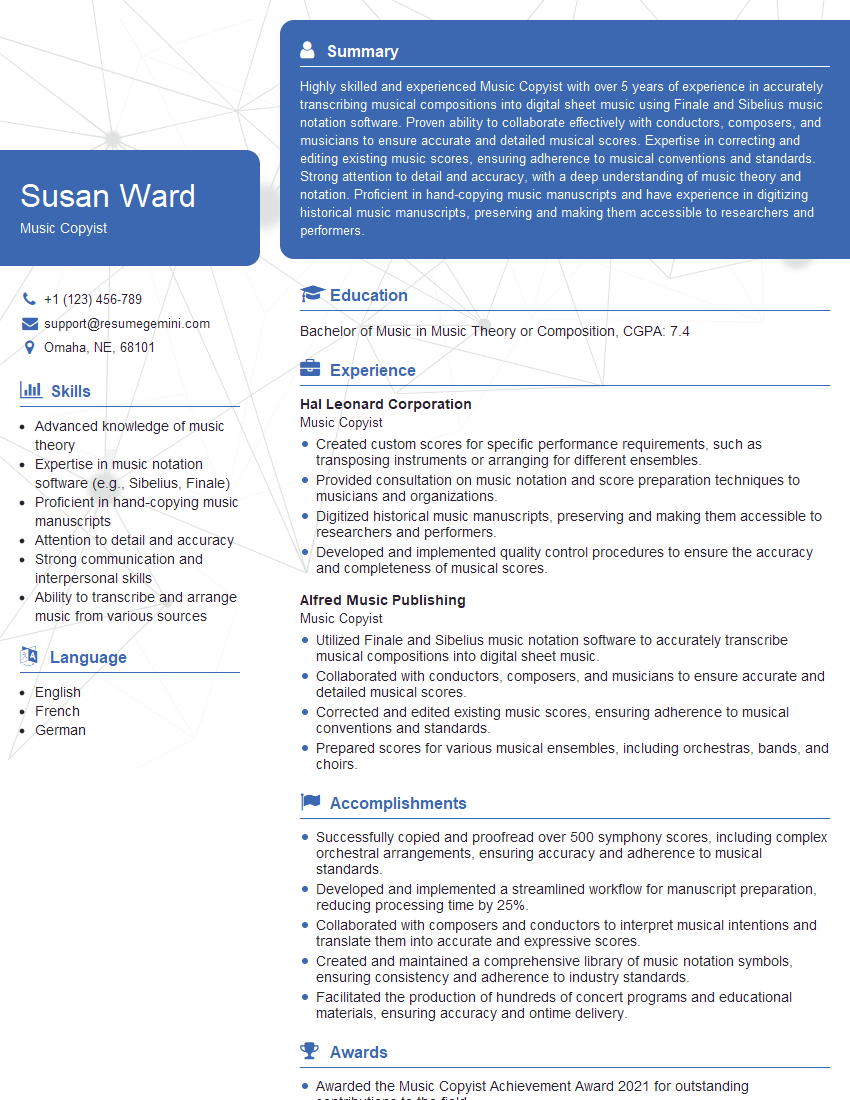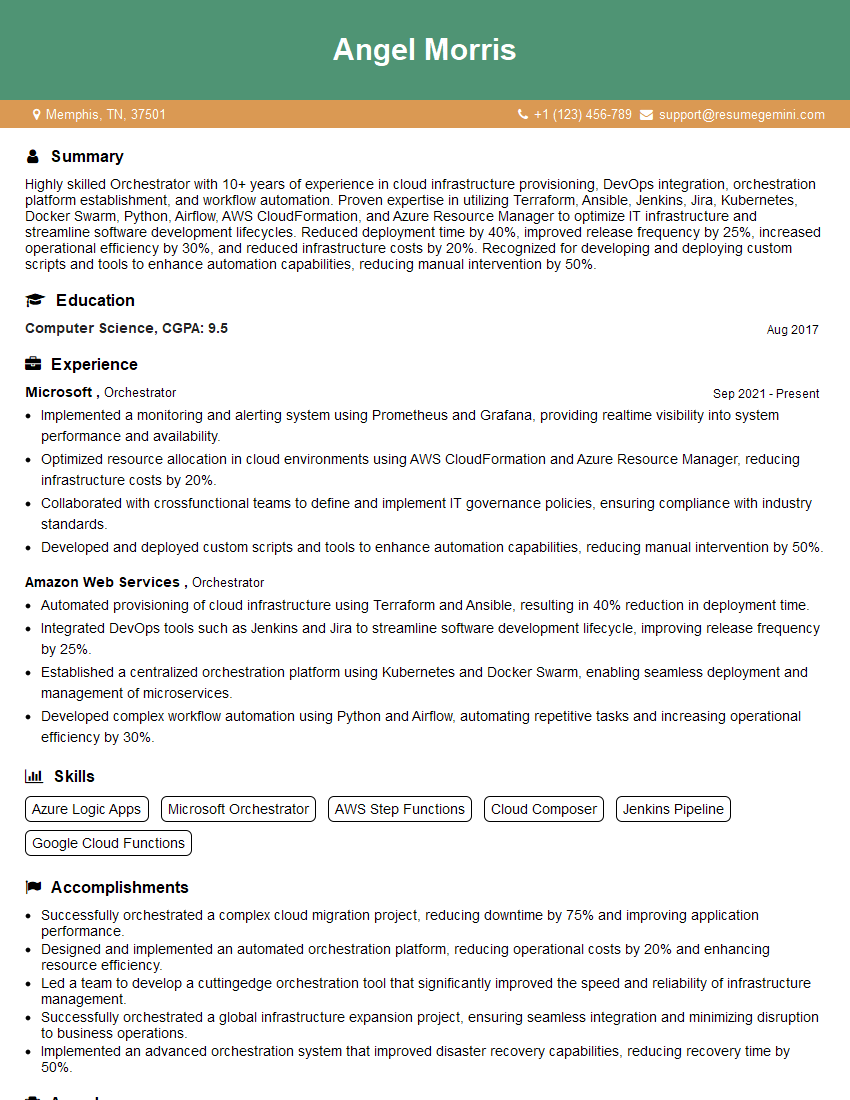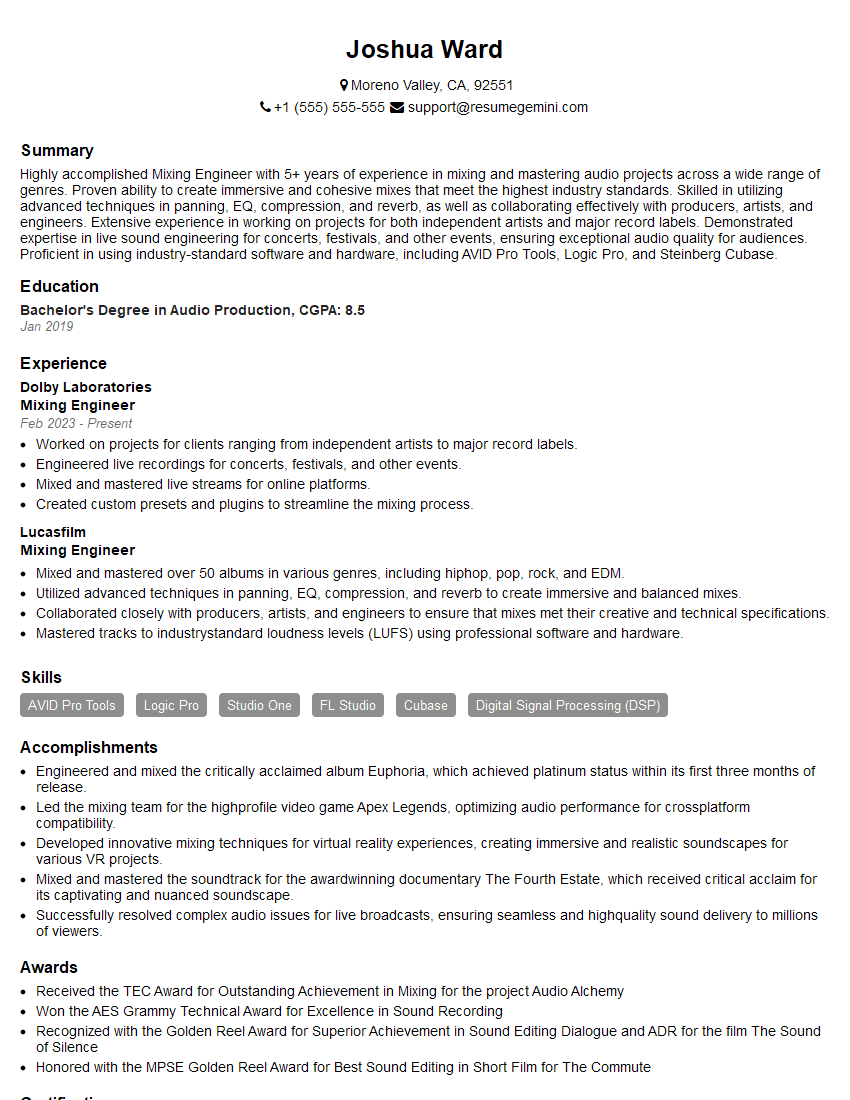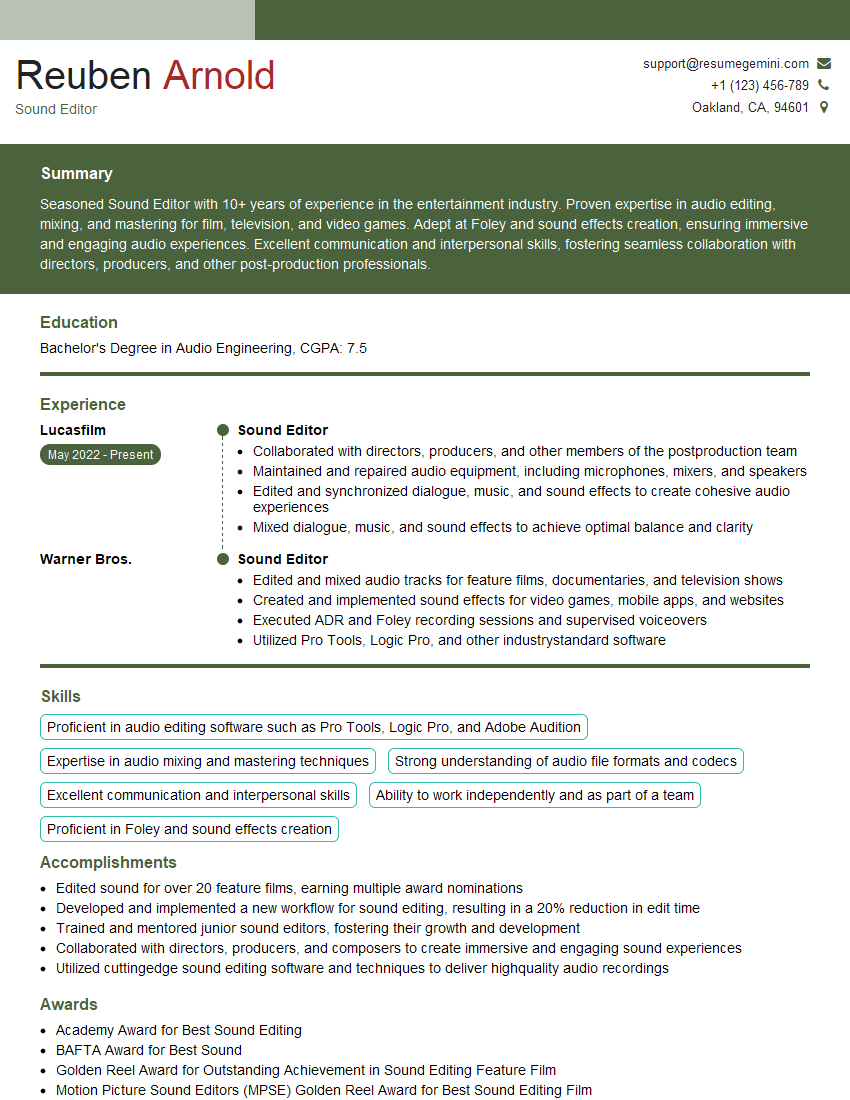Preparation is the key to success in any interview. In this post, we’ll explore crucial Expertise in Music Arrangement and Composition interview questions and equip you with strategies to craft impactful answers. Whether you’re a beginner or a pro, these tips will elevate your preparation.
Questions Asked in Expertise in Music Arrangement and Composition Interview
Q 1. Explain your approach to arranging music for different ensembles.
Arranging for different ensembles requires a deep understanding of each instrument’s capabilities and limitations. My approach begins with a thorough analysis of the source material – be it a solo piano piece, a choral work, or a rock song. I then consider the specific timbral and textural possibilities offered by the target ensemble. For instance, arranging a string quartet necessitates a focus on counterpoint and harmonic layering, whereas a big band arrangement might emphasize rhythmic complexity and instrumental solos.
I always start by sketching out the basic harmonic structure and rhythmic framework, allocating melodic lines and textures to different instrumental groups. For a string quartet arrangement of a piano piece, I might assign the piano’s bass line to the cello, the melody to the violin, and the inner voices to the viola and second violin, carefully considering the range and technical capabilities of each instrument. With a big band arrangement, I might focus on creating a strong rhythmic foundation with the rhythm section, building exciting call-and-response sections between the brass and saxophones. This process often involves several iterations of experimentation and refinement, balancing individual instrumental parts with the overall sonic picture.
Ultimately, the goal is to create a cohesive and engaging arrangement that showcases both the strengths of the ensemble and the essence of the original composition while honoring its aesthetic style. I might even experiment with unconventional voicings or instrumental combinations to add a unique flavor to the arrangement. For example, I might use a muted trumpet to create a softer, more melancholic texture in a big band piece.
Q 2. Describe your process for composing a melody.
Composing a melody is a deeply intuitive process, but it also involves a strong understanding of melodic structure and musical grammar. I often begin with a central idea – a short, memorable motif – that acts as a seed for the rest of the melody. This motif might emerge from a rhythmic idea, a specific harmonic progression, or even a purely emotional feeling. I then develop this motif through various techniques, such as sequential repetition (repeating the motif at a different pitch level), variation (altering the rhythm or contour of the motif), and fragmentation (breaking the motif into smaller parts).
I’m always mindful of the melodic contour – the overall shape of the melody – ensuring that it’s both interesting and memorable. A melody that consistently ascends or descends can become monotonous, so I try to incorporate a variety of directions and rhythms. I also consider the relationship between the melody and the underlying harmony. A good melody will complement the harmony without overpowering it. A strong melodic line has a sense of direction and resolution, often culminating in a satisfying cadence.
Sometimes I use software to experiment with different melodic ideas, but often, the initial stages are done on an instrument, allowing for a more spontaneous and intuitive approach. It is a creative exploration, frequently involving trial and error, until a melodic line emerges that feels satisfying both musically and emotionally.
Q 3. How do you create harmonic interest in your compositions?
Harmonic interest is crucial for keeping a listener engaged. I achieve this through a variety of techniques, avoiding predictable harmonic progressions. One of my key strategies is to incorporate unexpected chords or chord progressions, creating moments of surprise and intrigue. This could involve using secondary dominants, borrowed chords from parallel keys, or chromatic passing chords. For example, unexpectedly inserting a major chord within a minor key section can add a surprising burst of brightness or conflict.
Another method is to use voice leading – the careful movement of individual notes from one chord to the next – to create smooth and interesting transitions between harmonies. Good voice leading avoids awkward leaps and parallel fifths or octaves, creating a sense of flow and coherence. I also employ techniques like modal mixture, which involves borrowing chords from parallel modes, adding color and complexity to the harmonic landscape.
Furthermore, I might explore altered dominants or augmented chords to create a more sophisticated harmonic language. These chords add tension and release, leading to a richer listening experience. The use of harmonic rhythm—the frequency with which the harmony changes—also plays a vital role. A slower harmonic rhythm creates a sense of spaciousness and contemplation, while a faster harmonic rhythm can generate energy and excitement. It’s a delicate balance that I strive to master in every composition.
Q 4. Discuss your experience with different compositional techniques (e.g., serialism, minimalism).
My experience encompasses various compositional techniques, though I don’t rigidly adhere to any single style. Serialism, with its systematic organization of pitch and rhythm, has certainly influenced my approach to structure and organization. While I don’t compose strictly serial works, the principles of controlled variation and systematic development have informed my compositional thinking, especially in managing the development of themes and motifs.
Minimalism, with its focus on repetition and subtle variation, has also played a role. I appreciate the power of minimalism in creating hypnotic and immersive musical experiences. I often utilize repetitive rhythmic or melodic patterns as a foundation, subtly altering them over time to create a sense of gradual evolution and transformation. Think of the way Steve Reich uses phasing—gradually shifting rhythmic patterns—to build intense musical textures. I find similar techniques valuable in creating captivating and hypnotic passages.
However, my approach is eclectic. I draw inspiration from various historical styles and contemporary trends, adapting different compositional techniques to suit the specific demands of each project. I find that blending different techniques allows me to create unique and expressive musical works.
Q 5. How do you use counterpoint in your arrangements?
Counterpoint – the art of combining independent melodic lines – is an essential tool in my arrangements, particularly when working with ensembles featuring multiple melodic instruments. I use counterpoint to create richer textures and enhance harmonic interest. The simplest form involves two independent melodic lines moving in a way that enhances the harmony. A well-written counterpoint line supports and complements the main melody, adding depth without overshadowing it.
When composing counterpoint, I focus on several aspects. First, I ensure that the voices move smoothly and avoid parallel fifths or octaves, which sound jarring. Second, I pay close attention to the rhythmic interplay between the voices, creating both consonance and dissonance to create dynamic tension and release. Third, I consider the overall texture created by the combination of voices, aiming for a balance between clarity and richness.
For instance, in arranging a piece for strings, I might create a counterpoint between the violin and cello lines, where the cello plays a harmonically supportive line while the violin carries the melody. The counterpoint would be designed to create a sense of dialogue and interplay between the two instruments, enriching the musical experience. It’s a sophisticated technique that requires a deep understanding of music theory but yields incredibly rewarding results when executed well.
Q 6. Explain your workflow for creating a music arrangement from scratch.
My workflow for creating a music arrangement starts with careful listening and analysis of the source material. I identify key melodic and harmonic elements that need to be emphasized. Then I choose the instrumentation that best suits the style and character of the piece, understanding the capabilities and limitations of each instrument. I begin sketching the arrangement on paper or using music notation software, focusing on the overall harmonic and rhythmic structure.
Next, I start to develop individual instrumental parts, carefully considering their melodic and rhythmic contours, their interaction with the other parts, and their overall contribution to the texture. I might allocate specific melodic motives or harmonic progressions to particular instruments, considering their tonal and expressive qualities. I’ll experiment with different voicings and textures, exploring different ways to create a balanced and interesting sonic landscape.
The process is iterative, with constant refinement and revision. I frequently listen back to the arrangement, identifying areas that need improvement, such as resolving dissonances, improving transitions between sections, or enhancing the balance between different instrument groups. The final stage includes meticulous attention to details like articulation, dynamics, and phrasing, ensuring the arrangement is not only technically sound but also expressive and emotionally engaging.
Q 7. Describe your experience with music notation software (e.g., Sibelius, Finale).
I’m proficient in both Sibelius and Finale, two leading music notation software packages. My experience with these programs extends beyond basic notation; I’m comfortable using advanced features like advanced scoring, playback with virtual instruments, and audio import/export. I find Sibelius’s intuitive interface and powerful scoring capabilities particularly useful for large and complex arrangements. Finale’s strength lies in its comprehensive range of features and robust editing tools, which are invaluable for detailed refinement.
These programs are essential tools in my workflow, allowing me to create accurate and professional-quality scores quickly and efficiently. The ability to hear the arrangement played back with virtual instruments is crucial for detecting and correcting potential issues in voicing, balance, and overall texture before reaching the stage of live recording or performance. This ability to visualize and hear the music simultaneously is invaluable for creative exploration and refinement.
Beyond basic input, I use the software’s functionalities to analyze harmonic progressions, create detailed score layouts, and export the arrangement into multiple formats for different uses—from printed scores to digital audio files for distribution. My proficiency with these tools allows me to collaborate effectively with other musicians and efficiently deliver high-quality arrangements.
Q 8. How do you handle revisions and feedback on your compositions?
Revisions are crucial for refining a composition. I approach them as a collaborative process, valuing the feedback as an opportunity for improvement. I begin by carefully reviewing all comments, categorizing them into technical aspects (e.g., instrumentation, tempo), structural concerns (e.g., transitions, song form), and emotional impact (e.g., mood, lyrical interpretation).
For instance, if a client feels a section lacks emotional depth, I might explore adding string pads, altering the harmonic progression, or revising the melody to create a more evocative sound. I always maintain open communication, discussing the suggested changes and explaining my rationale behind any decisions. The goal is to achieve a final product that reflects both my artistic vision and the client’s needs. I usually provide revised versions in stages, allowing for iterative feedback and refinement.
Q 9. How do you ensure your arrangements are both musically effective and technically feasible?
Balancing musical effectiveness and technical feasibility is paramount. It’s like building a magnificent castle—you need a stunning architectural design (musical effectiveness) but also a solid foundation and structurally sound materials (technical feasibility). I start with a strong musical concept, considering the overall aesthetic and the intended emotional impact. Then, I meticulously analyze the arrangement to ensure it’s playable and realistically recordable. This involves considering factors such as instrumental ranges, dynamic contrasts, and rhythmic complexities.
For example, a soaring string melody might be technically challenging for a smaller ensemble. To address this, I might simplify the orchestration or rewrite the melody in a more manageable range. I also collaborate closely with musicians, getting their input on the practicality of the arrangement before committing to the final version. Software such as Sibelius or Finale assists greatly in scoring and analyzing technical feasibility.
Q 10. Describe your experience with different recording techniques and technologies.
My experience spans various recording techniques, from classic analog methods to cutting-edge digital processes. I’ve worked extensively with both live sessions and virtual instruments, adapting my approach based on the project’s requirements and budget. I am proficient with various Digital Audio Workstations (DAWs) such as Pro Tools, Logic Pro X, and Ableton Live, understanding their capabilities for mixing, mastering, and editing audio. With analog recording, I’ve explored using vintage microphones and tape machines to achieve warm, organic sounds, which often adds character to the recordings.
For example, in a recent project emphasizing a retro feel, we used ribbon microphones for a vintage vibe on the vocals. Conversely, for a more contemporary track, we employed extensive layering and vocal processing using digital plugins to create a dense, modern soundscape. My skillset encompasses a deep understanding of microphone techniques, signal processing, and equalization, allowing me to achieve optimal sound quality in diverse contexts.
Q 11. Explain your approach to working with musicians and producers.
Collaboration is at the heart of my creative process. I believe in open communication and mutual respect when working with musicians and producers. Before a session, I provide musicians with detailed scores and clear instructions, allowing ample time for preparation. During the recording, I foster a relaxed yet focused atmosphere, allowing the musicians to express their individual talents while adhering to the overall musical vision. I value their input and suggestions, understanding that their expertise adds layers of creativity I might miss.
With producers, I establish a collaborative workflow from the outset. This includes discussing creative direction, production timelines, and budgetary constraints. Regular check-ins and transparent communication ensure everyone is on the same page throughout the process. A recent example involved collaborating with a producer who had a unique approach to sound design. His insights enriched the project, resulting in an unexpected but successful sonic direction.
Q 12. How do you manage deadlines and time constraints in your work?
Managing deadlines requires meticulous planning and effective time management. I start by breaking down large projects into smaller, manageable tasks, creating a detailed schedule with realistic timelines for each stage of the process. This includes factoring in time for unexpected delays or revisions. I utilize project management tools to track progress, identify potential bottlenecks, and ensure I stay on track.
For instance, I might allocate specific days for composing, arranging, recording, and mixing, utilizing a Gantt chart to visualize the timeline and dependencies between tasks. Regular self-evaluation helps me identify areas where I’m falling behind and adjust my workflow accordingly. Transparency with clients about potential challenges ensures realistic expectations are set and avoids unnecessary stress.
Q 13. How do you adapt your compositional style to suit different genres or briefs?
Adaptability is key in music composition and arrangement. I approach different genres by deeply immersing myself in their specific characteristics, analyzing existing works, and understanding the conventions that define them. This includes examining typical instrumentation, harmonic structures, rhythmic patterns, and melodic contours. I then strategically integrate elements of the genre into my work while retaining my personal style and creative signature.
For example, when composing for a classical piece, I would focus on traditional harmonic progressions and orchestral instrumentation. In contrast, composing a pop song requires a different approach, focusing on catchy melodies, simple harmonic structures, and contemporary production techniques. I strive for stylistic cohesion while adapting to the specific requirements of the brief.
Q 14. How do you incorporate sound design principles into your arrangements?
Sound design is integral to effective arrangement. I view sound design as the art of sculpting the sonic environment, using both natural and synthetic sounds to create specific emotional and aesthetic effects. This goes beyond simply choosing instruments; it involves exploring the timbral possibilities of each instrument, using effects processing to enhance their characteristics, and creating layers of textures to enhance the overall sonic tapestry.
For example, I might use EQ and compression to shape the tone of a bass guitar, adding reverb to create spaciousness in a vocal recording, or using synthesizers and samplers to generate unique textures that complement the instrumentation. A good example might be using granular synthesis to create a shimmering, ethereal effect underlying a vocal melody, significantly enhancing the emotional weight of that section.
Q 15. Describe your experience with music theory and its application to arrangement and composition.
Music theory is the bedrock of arrangement and composition. It provides the grammar and vocabulary for creating meaningful musical expressions. My understanding encompasses harmony (understanding chord progressions, voice leading, and counterpoint), melody (creating memorable and expressive melodies), rhythm (structuring time and creating rhythmic interest), and form (organizing musical ideas into larger structures).
For example, understanding harmonic function allows me to craft compelling chord progressions that build tension and release. Knowing voice leading principles helps ensure smooth transitions between chords and prevents jarring harmonic clashes. Applying knowledge of rhythmic motifs creates a sense of unity and coherence throughout a piece. I use this theoretical framework not as rigid rules but as tools to shape and refine my creative process. In a recent project, I employed advanced harmonic techniques like altered dominants and secondary dominants to add color and sophistication to a seemingly simple pop song.
Career Expert Tips:
- Ace those interviews! Prepare effectively by reviewing the Top 50 Most Common Interview Questions on ResumeGemini.
- Navigate your job search with confidence! Explore a wide range of Career Tips on ResumeGemini. Learn about common challenges and recommendations to overcome them.
- Craft the perfect resume! Master the Art of Resume Writing with ResumeGemini’s guide. Showcase your unique qualifications and achievements effectively.
- Don’t miss out on holiday savings! Build your dream resume with ResumeGemini’s ATS optimized templates.
Q 16. Explain your understanding of different musical forms and structures.
Musical forms and structures provide blueprints for organizing musical ideas. Common forms include:
- Verse-Chorus: A popular form where verses present lyrical ideas and choruses provide a recurring, memorable refrain. This is adaptable to many genres.
- ABAB: A more classical form where sections A and B alternate, each with distinct melodies and harmonies. This allows for thematic development.
- Sonata Form: A complex form with exposition, development, and recapitulation sections, often used in classical music to explore thematic material.
- Rondo: A form characterized by a recurring main theme (A) interspersed with contrasting episodes (B, C, etc.). This is great for creating variety and memorability.
My understanding extends beyond these basic forms. I’m adept at blending and modifying forms, creating unique structures that suit the specific emotional and narrative aims of a piece. For instance, I might use a verse-chorus structure as a foundation but introduce unexpected bridges or interludes to create dramatic shifts in mood or tempo. This allows me to create something fresh and engaging while still leveraging the familiarity of established forms.
Q 17. How do you create a cohesive and compelling narrative arc in your compositions?
Creating a cohesive narrative arc in music is similar to storytelling. It involves establishing a mood, building tension, releasing that tension, and providing a satisfying resolution. This is achieved through several means:
- Thematic Development: Introducing a core musical idea (theme) and gradually transforming or developing it throughout the piece. This provides a sense of continuity.
- Dynamic Contrast: Alternating between quiet and loud passages to create emotional peaks and valleys.
- Harmonic Progression: Utilizing chord progressions that create tension and release, mirroring the emotional arc.
- Tempo and Rhythmic Changes: Shifting tempo and rhythmic patterns to reflect the evolving narrative.
For instance, I might begin a piece with a slow, melancholic melody and gradually increase the tempo and intensity, culminating in a powerful climax before returning to a peaceful resolution. This mirrors the emotional journey of a story, captivating the listener and creating a lasting impression.
Q 18. How do you use dynamics and rhythm to enhance the emotional impact of your music?
Dynamics (loudness and softness) and rhythm are powerful tools for enhancing emotional impact. Dynamics create contrast and emphasis, while rhythm drives the energy and feeling of the music.
A sudden crescendo (gradual increase in volume) can build tension effectively, while a diminuendo (gradual decrease in volume) can create a sense of reflection or peace. Similarly, a rhythmic shift from a steady, predictable pattern to a syncopated, irregular one can inject excitement and surprise. I often use rhythmic displacement and rhythmic layering to add complexity and depth to otherwise straightforward rhythmic patterns.
In a recent orchestral piece, I used a gradual crescendo leading up to a powerful fortissimo chord, followed by a sudden pianissimo section, creating a dramatic contrast that evoked a sense of awe and vulnerability. The interplay of these elements significantly impacted the overall emotional impact of the composition.
Q 19. Discuss your experience with different orchestration techniques.
Orchestration is the art of assigning instruments to different musical parts. My experience encompasses a wide range of techniques, including:
- Instrument Doubling: Assigning multiple instruments to play the same melody or harmony to create a richer, fuller sound.
- Counterpoint: Writing independent melodies that sound pleasing together, creating intricate textures.
- Timbral Coloration: Choosing instruments based on their sonic characteristics to achieve specific moods and effects.
- Layering: Building textures by stacking different instrumental parts.
I’m proficient in scoring for various ensembles, from small chamber groups to full orchestras. Understanding the unique capabilities of each instrument is critical. For example, I’d use the soaring sound of strings for a melancholic passage, while employing brass instruments for powerful, majestic moments. I strive to create a balanced and well-integrated orchestral texture that enhances the overall musical narrative.
Q 20. How do you ensure balance and clarity in your mixes and masters?
Achieving balance and clarity in mixes and masters is crucial for a professional-sounding product. It involves careful attention to detail and a deep understanding of audio engineering principles.
My process includes:
- EQ (Equalization): Shaping the frequency response of individual instruments and tracks to reduce muddiness and create space.
- Compression: Controlling dynamic range to create a more consistent and powerful sound.
- Panning: Positioning instruments in the stereo field to create a wide, spacious mix.
- Reverb and Delay: Adding ambience and depth to create a sense of space and realism.
- Automation: Creating dynamic changes in volume, panning, and effects over time.
I prioritize listening critically throughout the process, using reference tracks and various monitoring techniques to ensure that the mix translates well across different playback systems. The goal is to create a clear, detailed, and emotionally impactful listening experience.
Q 21. Explain your understanding of copyright and licensing in music.
Copyright and licensing are vital aspects of the music industry. Copyright protects the musical work, giving the creator exclusive rights to reproduce, distribute, and publicly perform it. Licensing grants permission to others to use the music under specific terms.
I have a thorough understanding of copyright law and different licensing models, including:
- Mechanical Licenses: For reproducing music on physical media or digital downloads.
- Synchronization Licenses: For using music in film, television, or other visual media.
- Performance Licenses: For performing music publicly.
I ensure that all my work is properly copyrighted and that any use of existing material is appropriately licensed. This understanding helps safeguard my creative assets and facilitates professional collaborations.
Q 22. Describe your experience collaborating with other composers or arrangers.
Collaboration is crucial in music arrangement and composition. I’ve had the pleasure of working with various composers and arrangers, each bringing unique perspectives and skills to the table. One particularly rewarding experience involved collaborating with a vocalist on a jazz project. She had a strong sense of melody and phrasing, but needed help arranging the accompaniment to complement her style. My role was to create a harmonic foundation that would support her vocal performance while also adding improvisational elements to keep the music dynamic and engaging. We used a iterative process, exchanging ideas and making adjustments based on feedback during rehearsals and recordings. This collaborative approach resulted in a stunning final product that exceeded our initial expectations. In another instance, I worked with a composer on a large-scale orchestral piece. His strength lay in composing powerful melodies and thematic development, whereas I focused on the intricate orchestration and ensuring a smooth transition between sections. This division of labor allowed us to leverage our individual expertise, optimizing the workflow and achieving a rich, well-balanced final composition.
Successful collaboration hinges on clear communication, mutual respect, and a willingness to compromise. It’s essential to understand each team member’s strengths and weaknesses to optimize the creative process. Effective communication during the process is crucial to ensure everyone is on the same page and to quickly address any creative differences that arise. Active listening and a willingness to adapt are vital components of successful collaborations.
Q 23. How do you stay updated with current trends in music arrangement and composition?
Staying current in the ever-evolving world of music arrangement and composition requires a multi-pronged approach. I regularly attend industry conferences and workshops, such as those hosted by NAMM or AES, to learn about new techniques and technologies. These events provide excellent opportunities for networking with other professionals and discovering cutting-edge trends. I also actively engage with online communities and forums dedicated to music production, including those on platforms like Reddit and various music technology forums. This allows me to access a wealth of information, including tutorials, critiques, and discussions on emerging trends. Moreover, I dedicate time to listening to diverse genres of music, paying attention not just to the melodies and harmonies, but also to the production techniques and arrangement choices. Carefully analyzing the work of other successful composers and arrangers provides invaluable insights into current styles and innovative approaches. Finally, I regularly explore new software and hardware, experimenting with plugins and synthesizers to stay ahead of the curve.
Q 24. Describe a challenging project and how you overcame the obstacles.
One challenging project involved composing and arranging music for a large-scale multimedia performance featuring live dancers, projections, and a live orchestra. The biggest hurdle was synchronizing the music with the choreographic movements and visual elements. The initial score I composed lacked the flexibility needed to respond dynamically to the shifting visual and choreographic elements. To overcome this, I adopted a modular approach, breaking down the score into smaller, self-contained sections. Each section was designed to be easily adjusted in length and intensity based on the specific needs of each scene. This modularity allowed for real-time adjustments during rehearsals, enabling me to seamlessly integrate the music with the other performance elements. We utilized detailed time-coded cue sheets and meticulous rehearsals to ensure precise synchronization, resulting in a unified and highly impactful performance.
Q 25. What are your strengths and weaknesses as a music arranger and composer?
My strengths lie in my ability to create compelling melodies and harmonies, combined with a strong understanding of orchestration and arrangement techniques. I’m adept at translating abstract musical ideas into tangible compositions, and I possess a keen ear for detail, ensuring a polished and professional-sounding final product. I also thrive in collaborative environments and enjoy working with diverse teams to achieve a shared artistic vision. However, I sometimes struggle with the business side of the industry, including marketing and self-promotion. Time management can also be a challenge, especially when juggling multiple projects simultaneously. I actively work on improving my business acumen through networking and professional development courses, and I’m continually refining my time management strategies to increase my efficiency.
Q 26. What are your long-term career goals in music?
My long-term career goals involve establishing myself as a respected and sought-after music arranger and composer. I aspire to create a diverse body of work that spans various genres and mediums, from film scoring to orchestral compositions. I aim to collaborate with talented artists and filmmakers, contributing to projects that have a positive impact on audiences and push the boundaries of creative expression. Beyond individual projects, I also hope to mentor and inspire aspiring composers and arrangers, sharing my knowledge and experience to foster the next generation of musical talent.
Q 27. What software and hardware do you use for music arrangement and composition?
My primary software for music arrangement and composition is Logic Pro X, although I also have experience with Ableton Live and Cubase. I rely heavily on a variety of virtual instruments and plugins, such as Spitfire Audio libraries for orchestral sounds, Native Instruments Komplete for synthesizers and effects, and Waves plugins for mixing and mastering. My hardware includes a high-quality audio interface (Focusrite Scarlett), studio monitors (Yamaha HS8), a MIDI keyboard controller (M-Audio Keystation), and a comfortable set of headphones (Sennheiser HD 280 Pro). The choice of software and hardware is always evolving; the best tools are those that best support my creative process and meet the requirements of each project.
Q 28. Give an example of how you used your skills to solve a problem in a previous project.
In a recent project for a theatrical production, the initial musical score felt disjointed and lacked a cohesive narrative arc. The problem was a lack of thematic consistency between the different scenes. To solve this, I identified a central theme early in the score and developed variations on that theme to represent different emotional states and character arcs. I used these variations to unify the disparate musical moments, creating a sense of continuity and narrative cohesion throughout the piece. This resulted in a much more powerful and impactful musical experience for the audience. Using a process of thematic development, rather than creating completely new melodies for each scene, greatly improved the overall flow and artistic impact of the score.
Key Topics to Learn for Expertise in Music Arrangement and Composition Interview
- Orchestration and Instrumentation: Understanding the sonic capabilities of different instruments and how to effectively arrange them for various musical styles and contexts. Consider practical application in scoring for different ensembles (string quartet, big band, etc.).
- Harmony and Counterpoint: Demonstrating a strong grasp of harmonic principles and voice leading techniques. Be prepared to discuss how you apply these concepts in creating compelling and engaging musical textures.
- Form and Structure: Understanding and applying various musical forms (sonata form, rondo, theme and variations, etc.) to create well-structured and impactful compositions and arrangements.
- Rhythm and Meter: Mastery of rhythmic complexities and syncopation, and the ability to create rhythmic interest and drive within your arrangements.
- Musical Style and Genre: Demonstrate familiarity with various musical styles and genres, and the ability to adapt your compositional and arrangement techniques to suit different contexts. Be ready to discuss your influences and stylistic preferences.
- Technology and Software Proficiency: Showcase expertise in relevant Digital Audio Workstations (DAWs) like Logic Pro X, Ableton Live, Pro Tools, etc. and notation software like Sibelius or Finale. Highlight your proficiency in MIDI editing, audio editing, mixing, and mastering.
- Aural Skills: Demonstrate strong aural skills, including dictation, transcription, and analysis. This demonstrates a deep understanding of music theory in practice.
- Problem-Solving and Creative Approaches: Be prepared to discuss how you approach creative challenges in arrangement and composition, such as overcoming technical limitations or achieving a specific emotional effect.
Next Steps
Mastering expertise in music arrangement and composition is crucial for career advancement in the music industry. A strong understanding of these concepts opens doors to diverse opportunities, from film scoring and game music to working with recording artists and composing for concert ensembles. To maximize your job prospects, creating an ATS-friendly resume is essential. ResumeGemini is a trusted resource that can help you build a professional resume that highlights your skills and experience effectively. Examples of resumes tailored to expertise in Music Arrangement and Composition are available to guide you through the process.
Explore more articles
Users Rating of Our Blogs
Share Your Experience
We value your feedback! Please rate our content and share your thoughts (optional).
What Readers Say About Our Blog
Hello,
We found issues with your domain’s email setup that may be sending your messages to spam or blocking them completely. InboxShield Mini shows you how to fix it in minutes — no tech skills required.
Scan your domain now for details: https://inboxshield-mini.com/
— Adam @ InboxShield Mini
Reply STOP to unsubscribe
Hi, are you owner of interviewgemini.com? What if I told you I could help you find extra time in your schedule, reconnect with leads you didn’t even realize you missed, and bring in more “I want to work with you” conversations, without increasing your ad spend or hiring a full-time employee?
All with a flexible, budget-friendly service that could easily pay for itself. Sounds good?
Would it be nice to jump on a quick 10-minute call so I can show you exactly how we make this work?
Best,
Hapei
Marketing Director
Hey, I know you’re the owner of interviewgemini.com. I’ll be quick.
Fundraising for your business is tough and time-consuming. We make it easier by guaranteeing two private investor meetings each month, for six months. No demos, no pitch events – just direct introductions to active investors matched to your startup.
If youR17;re raising, this could help you build real momentum. Want me to send more info?
Hi, I represent an SEO company that specialises in getting you AI citations and higher rankings on Google. I’d like to offer you a 100% free SEO audit for your website. Would you be interested?
Hi, I represent an SEO company that specialises in getting you AI citations and higher rankings on Google. I’d like to offer you a 100% free SEO audit for your website. Would you be interested?
good
